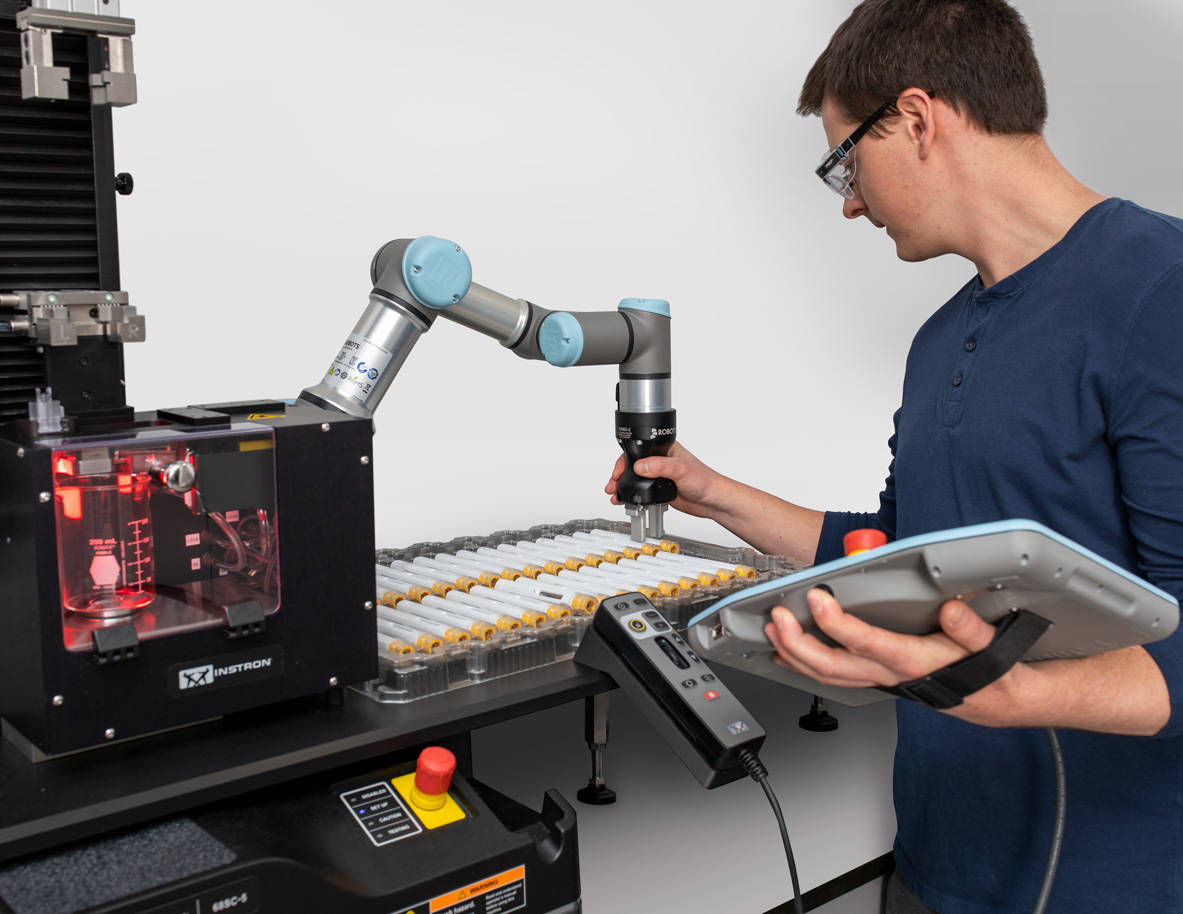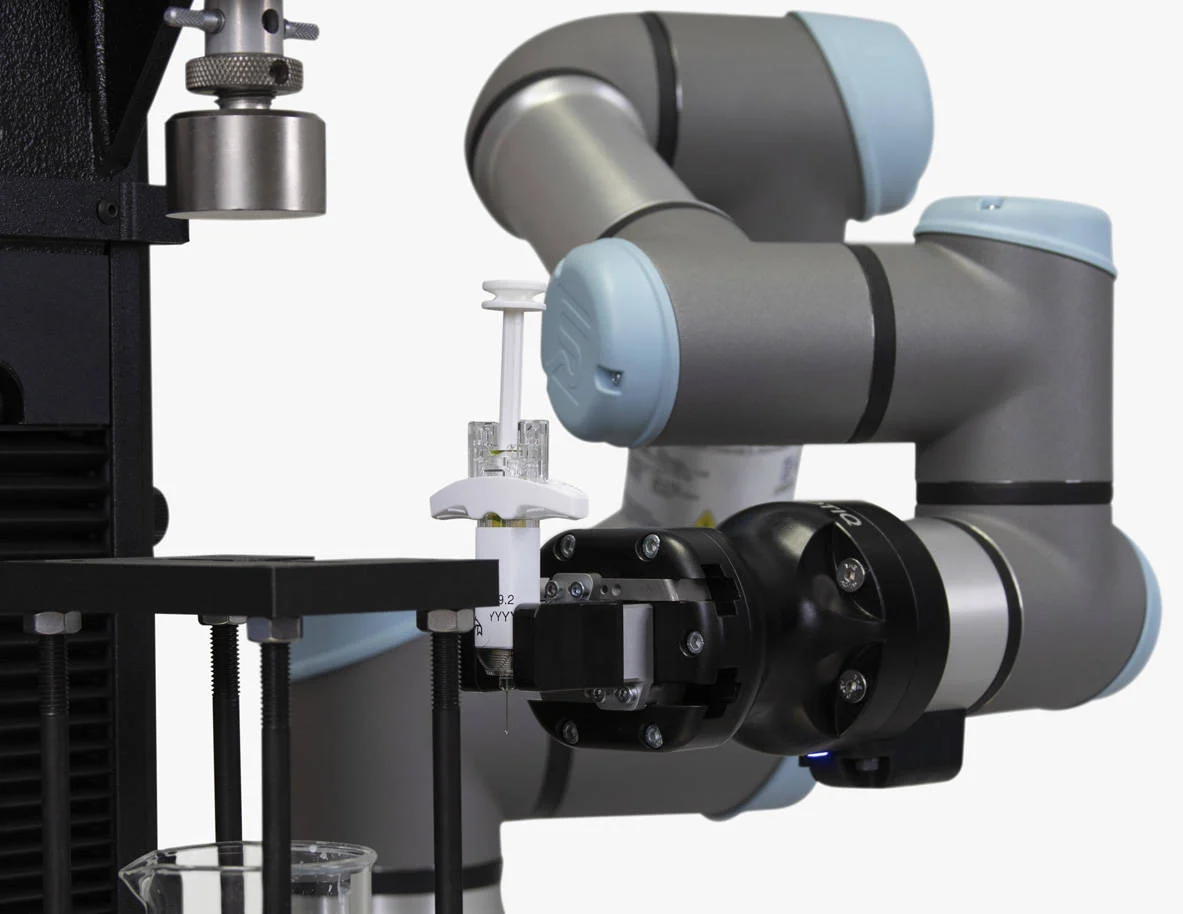The CT6 cobot testing system from Instron brings forth the advantages of automation to test biomedical devices and components.
This system couples a collaborative robot with a 5900 or 6800 Series universal testing system to increase the efficiency of small to mid-sized testing laboratories that require a high degree of adaptability in their testing systems.
The CT6 has been developed to tackle an extensive range of medical components, such as sample collection, drug delivery, and wound closure products.
Instron® | CT6 Cobot with Universal Testing System
Video Credit: Instron - USA
What Can a Cobot Do for the Lab?
Instron’s CT6 provides the advantages of automation to laboratories with shifting test needs and specimen geometries.
The CT6 combines an easy-to-program cobot with a universal testing machine and Bluehill® Universal software to better allow QC and DV laboratories to fulfill their increasing testing demand while enhancing the entire dependability of the data.
Using the CT6 prevents the hassles linked to utilizing third party integrators by leveraging Instron’s automation abilities and application expertise.

Image Credit: Instron - USA
Improved Lab Efficiency
The CT6 is a perfect automation solution available for small to mid-sized labs where engineers frequently spend valuable time operating testing systems. The CT6 acts separately to load specimens, unload specimens, and run tests, enabling skilled operators to commit more time to value-added activities.
User-Driven Flexibility
The CT6 is developed to be rapidly and easily programmed with little to no assistance from Instron. This implies that testing new devices or specimen sizes could be automated in-house with the least time needed for the initial setup.

Image Credit: Instron - USA
Enhanced Safety and Ergonomics
The CT6 eases risk by ensuring that the operator doesn’t have to stay near the frame while it is in motion. It also decreases operator interaction with dangerous specimens like sharps and prevents the strains linked to repetitive loading and unloading of the system.
Improved Data Repeatability
Using the CT6 removes any operator-introduced errors concerning specimen alignment or data collection.

Image Credit: Instron - USA
CT6 In the Lab
The CT6 is developed to be paired with present or purpose-built fixturing to execute tests on an extensive range of products and components. The automation team can assist in designing and developing all specimen racking and automation-ready fixtures.
Instead, users can use the CT6 as an extra tool with their equipment, and let the in-house design teams figure out how to use it. Here are some common ways to use the CT6 to add easy pick-and-pull automation to the lab.
Autoinjector Testing
Manufacturers of autoinjectors and other needle-based injection systems are gradually increasing production to fulfill the increasing global demand for safe and convenient forms of drug delivery.
Getting these devices from the development stage to production is a prolonged process with rigorous usability and functional testing requirements via every stage of product development.
The CT6 is perfect for testing several product design iterations with the least changeover time. This decreases the need for highly technical design engineers to stand in front of a system.
With a cobot solution, the devices can instantly be positioned in the production tray on the test system and left while the machine runs the essential tests. This eventually enables the technician to achieve other value-added tasks.
CT6 Cobot Configured for Auto-Injector Testing
Video Credit: Instron - USA
Syringe Testing
Break loose and glide force testing composes the bulk of syringe testing and is utilized to identify the real-world forces needed to operate the syringe. Pre-filled syringes are combination devices needing device verification testing before an NDA can be submitted.
Cobots can be positioned individually or in-lined to enhance efficiency and throughput in both applications. Completely integrated manufacturing systems use quantified break loose or glide force data to alter real-time production settings to rectify any out-of-tolerance values.
CT6 Cobot Configured for Syringe Testing
Video Credit: Instron - USA
Syringe Closure Testing
Prefilled syringes have extensive closure systems, such as rigid needle shields and screw-on tip caps.
ISO 11040-4 is the global standard illustrating the test procedures essential to assess the closures' performance.
Annex G.5 evaluates the elimination torque of rigid tip caps utilized jointly with female luer lock connections. When utilized with a torsion-enabled universal testing system, a cobot is extremely useful for laboratory productivity, operating as a pick-and-place operation to decrease operator influence.
The repeatability of automated specimen insertion is perfect for enhancing device alignment, a considerable contributor to data spread.
As prefilled syringes are available in various capacities, the sample racking can be tailored to house all possible device geometry, and the seamless integration with Bluehill Universal implies test techniques for new devices can be created rapidly.
CT6 Cobot Configured for Torsion Testing
Video Credit: Instron - USA
Specifications
Source: Instron - USA
| . |
. |
| Payload |
3 kg | 6.6 lbs |
| Reach |
500 mm | 19.7 in |
| Weight |
11 kg | 24.3 lbs |
| Speed (TCP) |
1 mm/sec | 39.4 in/sec |
| Repeatability |
±0.03 mm |
| Power Consumption |
300 W |
| Operating Temperature |
0-50 °C | 32-122 °F |
| Humidity |
90% RH |